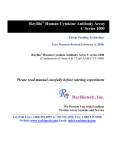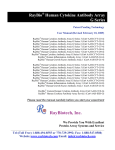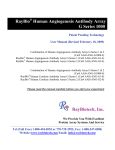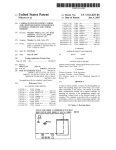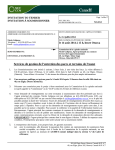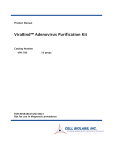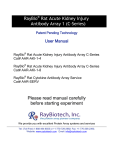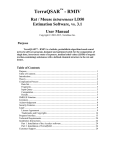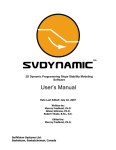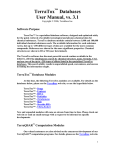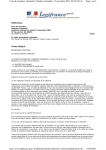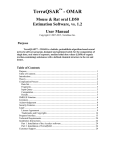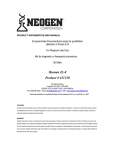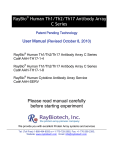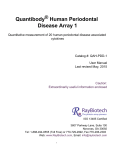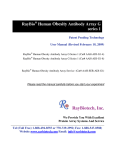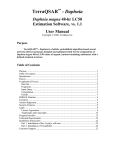Download Human Angiogenesis Antibody Array C series 1000
Transcript
RayBio® Human Angiogenesis Antibody Array C Series 1000 Patent Pending Technology User Manual (Revised February 4, 2009) RayBio® Human Angiogenesis Antibody Array C series 1000 Combination of Arrays 1 & 2 (Cat# AAH-ANG-1000) RayBio® Human Angiogenesis Antibody Array 1 (Cat# AAH-ANG-1) RayBio® Human Angiogenesis Antibody Array 2 (Cat# AAH-ANG-2) Please read manual carefully before starting experiment RayBiotech, Inc. We Provide You with Excellent Protein Array Systems and Service Tel:(Toll Free) 1-888-494-8555 or 770-729-2992; Fax: 1-888-547-0580; website: www.raybiotech.com Email: [email protected] RayBiotech, Inc. RayBio® Human Angiogenesis Antibody Array C Series 1000 Protocol TABLE OF CONTENTS I. Introduction……..……………………………... 2 How It Works………………………..………… 4 Materials Provided…………………………….. 5 Additional Materials Required………………… 5 III. Overview and General Considerations………… 6 A. Preparation of Samples……………………… 6 B. Handling Array Membranes…………………. 6 C. Incubation…………………………………… 6 IV. Protocol………………………………………… 7 A. Blocking and Incubation……………………. 7 B. Detection……………………………………. 9 Interpretation of Results……………………….. 10 VI. Troubleshooting Guide………………………… 14 VII. Reference List…………………………………. 15 II. V. Angiogenesis antibody arrays are RayBiotech patent-pending technology. RayBio® is the trademark of RayBiotech, Inc. RayBio® Human Angiogenesis Antibody Array C Series 1000 1 I. Introduction All cell functions, including cell proliferation, cell death and differentiation, as well as maintenance of health status and development of disease, are controlled by a multitude of genes and signaling pathways. New techniques such as cDNA microarrays have enabled us to analyze global gene expression 1-3. However, almost all cell functions are executed by proteins, which cannot be studied simply through DNA and RNA techniques. Experimental analysis clearly shows a disparity between the relative expression levels of mRNA and their corresponding proteins 4. Therefore, analysis of the protein profile is critical. Currently, two-dimensional polyacrylamide SDS page coupled with mass spectrometry is the mainstream approach to analyzing multiple protein expression levels 5,6. However, the requirement of sophisticated devices and the lack of quantitative measurements greatly limit their broad application. Thus, effective study of multiple protein expression levels has been complicated, costly are timeconsuming until now. Our RayBio® Human Angiogenesis antibody array is the first commercially available protein array system 7-11. By using the RayBiotech system, scientists can rapidly and accurately identify the expression profiles of multiple cytokines in several hours inexpensively. The RayBiotech kit provides a simple array format, and highly sensitive approach to simultaneously detect multiple cytokine expression levels from conditioned media, patient’s sera, cell lysate, tissue lysates and other sources. Traditionally, cytokines are detected by using ELISA. However, RayBiotech’s approach has several advantages over ELISA. First, and most importantly, our approach can detect many cytokines simultaneously. Secondly, sensitivity is greatly increased. As little as 4 pg/ml of MCP-1 can be detected using the protein array format. In contrast, at least 40 pg/ml of MCP-1 is required to produce a clear signal in an ELISA assay. Furthermore, the detection range is much greater than ELISA. For example, the detection range of IL-2 varies from 25 to 250,000 pg/ml using RayBiotech technology, whereas the detection range varies only within 100-1000 fold in a typical RayBio® Human Angiogenesis Antibody Array C Series 1000 2 ELISA. Therefore, the detection range is greater with protein array compared with ELISA. The variation is lower than ELISA as well. As determined by densitometry, the variation between two spots ranged from 0 to 10% in duplicated experiments. In contrast, variation (about 20%) in ELISA is much higher. Finally, the system is much quicker and can be much easier to adapt to high-throughput technique. Pathway-specific array systems allow investigators to focus on the specific problem and are becoming an increasingly powerful tool in cDNA microarray systems. RayBiotech’s first protein array system, known as RayBio® Human Angiogenesis antibody array, is particularly useful in comparison with the human cytokine cDNA microarray system. Besides the ability to detect protein expression, RayBiotech’s system is a more accurate reflection of active cytokine levels because it only detects secreted cytokines, and no amplification step is needed. Furthermore, it is much simpler, faster, environmentally friendlier, and more sensitive. Simultaneous detection of multiple cytokines undoubtedly provides a powerful tool to study cytokines. Cytokines play an important role in innate immunity, apoptosis, angiogenesis, cell growth and differentiation 12. Cytokines are involved in most disease processes, including cancer and cardiac diseases. The interaction between cytokines and the cellular immune system is a dynamic process. The interactions of positive and negative stimuli, and positive as well as negative regulatory loops are complex and often involve multiple cytokines. Without doubt, simultaneous detection of multiple cytokines provides a powerful tool to study cytokines. 1. LPS induces the interaction of a transcription factor, LPS-induced TNF-a factor, and STAT6(B) with effects on multiple cytokines. Tang X, Marciano DL, Leeman SE, Amar S. PNAS. 2005;102(14):5132-5137. 2. HIV-1-mediated apoptosis of neuronal cells: Proximal molecular mechanisms of HIV-1-induced encephalopathy. Xu Y, Kulkoshy J, Pomerantz RJ. PNAS. RayBio® Human Angiogenesis Antibody Array C Series 1000 3 2004;101(18). 3. Synergistic increases in intracellular Ca(2+), and the release of MCP-1, RANTES, and IL-6 by astrocytes treated with opiates and HIV-1 Tat. GLIA. 2005;50(2):91-106. 4. Bone Marrow Stroma Influences Transforming Growth Factor-β Production in Breast Cancer Cells to Regulate c-myc Activation of the Preprotachykinin-I Gene in Breast Cancer Cells. Oh HS, Moharita A, Rameshwar P. Cancer Res. 64, 6327-6336. 5. Recombinant Herpes Simplex Virus Type 1 (HSV-1) Codelivering Interleukin-12p35 as a Molecular Adjuvant Enhances the Protective Immune Response against Ocular HSV-1 Challenge J Virol. 2005:79(6):. 6. Dysregulated Inflammatory Response to Candida albicans in a C5-Deficient Mouse Strain. Mullick A, Elias M, Picard S, Gros P. Infect Immunity, Oct. 2004, p. 5868-5876. 7. Leukotriene B4 Strongly Increases Monocyte Chemoattractant Protein-1 in Human Monocytes. Huang L, Zhao A, Wong F, Ayala JM, Cui J. Arterioscler Thromb Vascul Biol. 2004;24:1783-1788 8. Human CD1d-unrestricted NKT cells release chemokines upon Fas engagement. Giroux M, Denis F. Blood. 2005;105(2):703-710. 9. Monitoring the response of orthotopic bladder tumors to granulocyte macrophage colony-stimulating factor therapy using the prostate-specific antigen gene as a reporter. Wu Q, Esuvaranathan K, Mahendran R. Clin Cancer Res. 2004; 10(20):6977-84. 10. Neuroglial activation and neuroinflammation in the brain of patients with autism (p NA). Vargas DL, Nascimbene C, Krishnan C, Zimmerman AW, Pardo CA. Ann Neurology. 2005 Jan 1; DOI: 10.1002/ana.20315 11. Cytokine profiling of macrophages exposed to Porphyromonas gingivalis, its LPS or its FimA. Zhou Q, Desta T, Graves DT, Amar S. Infect Immunity (IAI). 2005 Feb;73(2):935-43. RayBio® Human Angiogenesis Antibody Array C Series 1000 4 Here’s how it works Array support Sample Incubation of Sample With arrayed antibody Supports Cocktail of Biotin-Ab Incubation with Biotinylated Ab 1-2 hrs 1-2 hrs Labeled – streptavidin Incubation with Labeled- streptavidin 2 hrs Detection of signals Data analysis and graph RayBio® Human Angiogenesis Antibody Array C Series 1000 5 II. Materials Provided Upon receipt, all components of the RayBio® Human Cytokine Antibody Array kit should be stored at -20°C to -80°C. At -20°C to -80°C the kit will retain complete activity for up to 6 months. Once thawed, the array membranes and 1X Blocking Buffer should be kept at –20°C and all other component should be stored at 4°C. After thawing the reagents, the kit must be used within three months, and please use the kit within six months of purchase. • RayBio® Human Angiogenesis antibody array membranes (2/4/8 array membranes 1 and 2/4/8 array membranes 2) • Biotin-Conjugated Anti-Cytokines (1/2/4 tubes, each tube for two membranes) • 1,000X HRP-Conjugated Streptavidin (50 μl) • 1X Blocking Buffer (25/50 ml) • 20X Wash Buffer I (10/20 ml) • 20X Wash Buffer II (10/20 ml) • 2X Cell Lysis Buffer (10/20 ml) • Detection Buffer C (1.5/2.5 ml) • Detection Buffer D (1.5/2.5 ml) • Eight-Well Tray (1 each) • Manual Additional Materials Required • • • • Small plastic boxes or containers Orbital shaker Plastic sheet protector or SaranWrap Kodak X-Omat AR film (REF 165 1454) and film processor or Chemiluminescence imaging system RayBio® Human Angiogenesis Antibody Array C Series 1000 6 III. Overview and General Considerations A. Preparation of Samples • Use serum-free conditioned media if possible. • If serum-containing media is required, use an uncultured media aliquot as a negative control sample, since many types of sera contain cytokines. • For cell lysates and tissue lysates, we recommend using RayBio® Cell Lysis Buffer to extract proteins from cell or tissue (e.g. using homogenizer). Dilute 2X RayBio® Cell Lysis Buffer with H2O (we recommend adding proteinase inhibitors to Cell Lysis Buffer before use). After extraction, spin the sample down and save the supernatant for your experiment. Determine protein concentration. • We recommend using per membrane: o 1 ml of Conditioned media (undiluted), or o 1 ml of 2-fold to 5-fold diluted sera or plasma, or o 50-500 μg of total protein for cell lysates and tissue lysates (use ~200-250 μg of total protein for first experiment) Dilute the lysate at least 10 fold with 1 X blocking buffer. Note: The amount of sample used depends on the abundance of adipokines. More of the sample can be used if the signals are too weak. If the signals are too strong, the sample can be diluted further. If you experience high background, you may further dilute your sample. B. Handling Array Membranes • Always use forceps to handle membranes, and grip the membranes by the edges only. • Never allow the array membranes to dry during experiments. RayBio® Human Angiogenesis Antibody Array C Series 1000 7 C. Incubation • Completely cover the membranes with sample or buffer during incubation, and cover the eight-well tray with lid to avoid drying. • Avoid foaming during incubation steps. • Perform all incubation and wash steps under gentle rotation. • Several incubation steps such as step 2 (blocking), step 3 (sample incubation), step 8 (biotin-Ab incubation) and step 11 (HRPstreptavidin incubation) may be done at 4°C for overnight, but make sure to cover the 8 well plate tightly to prevent evaporation. IV. Protocol A. Blocking and Incubation 1. Place one array membrane 1 (top left corner marked with “1”), and one array membrane 2 (top left corner marked with “2”) into the same well of the provided eight-well tray (“1” or “2” marked side is the antibody printed side). 2. Add 2 ml 1X Blocking Buffer and incubate at room temperature for 30 min to block membranes. Make sure there are no bubbles between the membranes. 3. Decant Blocking Buffer from each container, and incubate membranes with sample at room temperature for 1 to 2 hours. Dilute sample using 1X Blocking Buffer if necessary. Note: We recommend using 1.2 ml of undiluted conditioned media or 1.2 ml of 2-fold to 10-fold diluted sera or plasma or ~200-250 ug ( range: 50500 ug) of total protein for cell lysates and tissue lysates. Dilute the lysate at least 10 fold with 1 X blocking buffer. Add some samples between array membranes I and II. Make sure there are no bubbles between membranes. RayBio® Human Angiogenesis Antibody Array C Series 1000 8 Note: The amount of sample used depends on the abundance of cytokines. More of the sample can be used if the signals are too weak. If the signals are too strong, the sample can be diluted further. Note: Incubation may be done at 4°C for overnight. 4. Decant the samples from each container, and wash 3 times with 2 ml of 1X Wash Buffer I at room temperature with shaking. Please allow 5 min per wash. Dilute 20X Wash Buffer I with H2O. 5. Wash 2 times with 2 ml of 1X Wash Buffer II at room temperature with shaking. Allow 5 min per wash. Dilute 20X Wash Buffer II with H2O. 6. From this step, place array membrane 1 marked with “1”) into one well, array membrane 2 marked with “2”) into another well. 7. Prepare working solution for biotin-conjugated antibodies. Add 100 μl of 1x blocking buffer to the Biotin-Conjugated Antibody 1 tube. Mix gently and transfer all mixture to a tube containing 2 ml of 1x blocking buffer. Add 100 μl of 1x blocking buffer to the Biotin-Conjugated Antibody 2 tube. Mix gently and transfer all mixture to a tube containing 2 ml of 1x blocking buffer. Note: the diluted biotin-conjugated antibodies can be stored at 4°C for 23 days. 8. Add 1 ml of diluted biotin-conjugated antibodies to each membrane (1 ml of diluted biotin-conjugated antibodies 1 to array membrane 1 marked with “1” and 1 ml of diluted biotin-conjugated antibodies 2 to array membrane 2 marked with “2”). Incubate at room temperature for 1-2 hours. Note: incubation may be done at 4°C for overnight. RayBio® Human Angiogenesis Antibody Array C Series 1000 9 9. Wash as directed in steps 4 and 5. 10. Add 2 ml of 1,000 fold diluted HRP-conjugated streptavidin (e.g. add 2 µl of HRP-conjugated streptavidin to 1998 µl 1X Blocking Buffer) to each membrane. Note: mix tube containing 1,000X HRP-Conjugated Streptavidin well before use since precipitation may form during storage. 11. Incubate at room temperature for 2 hours. Note: incubation may be done at 4°C for overnight. 12. Wash as directed in steps 4 and 5. B. Detection * Do not let the membrane dry out during detection. The detection process must be completed within 40 minutes without stopping. 1. Proceed with the detection reaction. Add 250 μl of 1X Detection Buffer C and 250 μl of 1X Detection Buffer D for one membrane; mix both solutions; Drain off excess wash buffer by holding the membrane vertically with forceps. Place membrane protein side up (“1“or “2” mark is on the protein side top left corner) on a clean plastic sheet (provided in the kit). Transfer the mixed Detection Buffer onto the membrane and incubated at room temperature for 2 minutes. Ensure that the detection mixture is completely and evenly covers the membrane without any air bubbles. 2. Drain off any excess detection reagent by holding the membrane vertically with forceps and touching the edge against a tissue. Gently place the membrane, protein side up, on a piece of plastic sheet (“1“ or “2” mark is on the protein side top left corner). Cover with another piece RayBio® Human Angiogenesis Antibody Array C Series 1000 10 of plastic sheet on the array. Gently smooth out any air bubbles. Avoid using pressure on the membrane. 3. Expose the array to x-ray film (we recommend to use Kodak X-Omat AR film) and detect the signal using film developer. Or the signal can be detected directly from the membrane using a chemiluminescence imaging system. Expose the membranes for 40 seconds. Then re-expose the film according to the intensity of signals. If the signals are too strong (background too high), reduce exposure time (e.g. 5-30 seconds). If the signals are too weak, increase exposure time (e.g. 5-20 min or overnight), or re-incubate membranes overnight with 1x HRP-conjugated streptavidin, and redo detection on the second day. 4. Save membranes in –20 °C to –80 °C for future reference. RayBio® Human Angiogenesis Antibody Array C Series 1000 11 V. Interpretation of Results: The following figure shows RayBio® Human Angiogenesis antibody array membranes C series 1000 probed with different patient’s plasma. Membranes were exposed to Kodak X-Omat film at room temperature for 1 minute. The biotin-conjugated IgG produces positive signals, which can be used to identify the orientation and to compare the relative expression levels among the different membranes. One important parameter is background. To obtain the best results, we suggest that several exposures be attempted. We also strongly recommend using a negative control in which the sample is replaced with an appropriate mock buffer according to the array protocol, particularly during your first experiment. Angiogenesis antibody array I II Condition medium Control By comparing the signal intensities, relative expression levels of cytokines can be made. The intensities of signals can be quantified by densitometry. The positive control can be used to normalize the results from the different membranes being compared. The signals also can be detected and quantified by using a chemiluminescence-imaging device. RayBio® Human Angiogenesis Antibody Array C Series 1000 12 The RayBio® Analysis Tool is a program specifically designed for analysis of RayBio® Angiogenesis antibody arrays. This tool will not only assist in compiling and organizing your data, but also reduces your calculations to a “copy and paste.” Call RayBiotech, Inc. at 770-729-2992 for ordering information. RayBio® Human Angiogenesis Antibody Array 1 A B C D E F G H 1 POS POS NEG NEG Angiogenin EGF ENA-78 b FGF 2 POS POS NEG NEG Angiogenin EGF ENA-78 b FGF 3 GRO IFN-γ IGF-I IL-6 IL-8 LEPTIN MCP-1 PDGF-BB 4 GRO IFN-γ IGF-I IL-6 IL-8 LEPTIN MCP-1 PDGF-BB 5 PIGF RANTES TGF-β1 TIMP-1 TIMP-2 Thrombopoietin VEGF VEGF-D 6 PIGF RANTES TGF-β1 TIMP-1 TIMP-2 Thrombopoietin VEGF VEGF-D 7 BLANK BLANK BLANK BLANK BLANK BLANK Neg POS 8 BLANK BLANK BLANK BLANK BLANK BLANK Neg POS Note: GRO detects CXCL1, CXCL2, CXCL3 Note: TGF-β1 detects only active form Note: VEGF detects VEGF-165 and VEGF-121 RayBio® Human Angiogenesis Antibody Array 2 a b c d e f g h 1 POS POS NEG NEG Angiopoietin-1 Angiopoietin-2 Angiostatin Endostatin 2 POS POS NEG NEG Angiopoietin-1 Angiopoietin-2 Angiostatin Endostatin 3 G-CSF GM-CSF I-309 IL-10 IL-1α IL-1β IL-2 IL-4 4 G-CSF GM-CSF I-309 IL-10 IL-1α IL-1β IL-2 IL-4 5 I-TAC MCP-3 MCP-4 MMP-1 MMP-9 PECAM-1 Tie-2 TNF-α 6 I-TAC MCP-3 MCP-4 MMP-1 MMP-9 PECAM-1 Tie-2 TNF-α 7 u PAR VEGF R2 VEGF R3 BLANK BLANK BLANK BLANK POS 8 u PAR VEGF R2 VEGF R3 BLANK BLANK BLANK BLANK POS We also offer Custom Human Cytokine Antibody Arrays. You can select the cytokines of interest from the following list and we will produce the customized array at an affordable price. For more information, please visit our website, www.raybiotech.com. RayBio® Human Angiogenesis Antibody Array C Series 1000 13 Human Custom Antibody Array List (285 proteins) 4-1BB/TNFRSF9 CNTF GDNF IL-18 R alpha MIP-1 alpha SCF ACE-2 Cripto-1 GITR IL-18 R beta MIP-1 beta SCF R Activin A CRP GITR Ligand IL-1ra MIP-1 delta SDF-1 alpha Adiponectin/Acrp30 CTACK/CCL27 GM-CSF IL-2 MIP-3 alpha SDF-1 beta Adipsin/Factor D CTLA-4 GRO IL-2 R alpha MIP-3 beta sgp130 AFP CXCL16 GRO-a IL-2 R beta MMP-1 Shh N AgRP(ART) DAN Growth Hormom IL-2 R gamma MMP-2 Siglec-5 ALCAM Decorin HB-EGF IL-21 R MMP-3 Siglec-9 Angiogenin DKK-1 HCC-4/CCL16 IL-22 MMP-7 sTNF RII Angiopoietin-1 DKK-3 hCGa, intact IL-28A/IFN-lambda MMP-8 sTNT RI Angiopoietin-2 DKK-4 HGF IL29/IFN-lambda 1 MMP-9 TACE Angiostatin DPPIV/CD26 HVEM IL-3 MMP-10 TARC ANGPTL4 DR6 I-309 IL-31 MMP-13 TECK/CCL25 AR (amphiregulin) Dtk ICAM-1 IL-4 MPIF-1 TGF-alpha Axl E-Cadherin ICAM-2 IL-5 MSP a Chain TGF-beta 1 B7-1(CD80) EDA-A2 ICAM-3 IL-5 R alpha NAP-2 TGF-beta 2 Bate2 M EGF IFN-gamma IL-6 NCAM-1 TGF-beta 3 BCAM EGF R IGFBP-1 IL-6 sR NGF R Thyroglobulin BCMA/TNFRSF17 EG-VEGF/PK1 IGFBP-2 IL-7 Nidogen-1/Entactin Tie-1 BDNF ENA-78 IGFBP-3 IL-8 NrCAM Tie-2 beta IG-H3 Endoglin IGFBP-4 IL-9 NRG1-beta 1/HRG1-beta 1 TIM-1 Betacellulin (BTC) Endostatin IGFBP-5 IL-9 R NT-3 TIMP-1 bFGF Eotaxin IGFBP-6 Insulin NT-4 TIMP-2 BLC Eotaxin-2 IGF-I IP-10 Oncostatin M TIMP-4 BMP-4 Eotaxin-3 IGF-I sR I-TAC/CXCL11 Osteopontin TNF-alpha BMP-5 EpCAM/TROP1 IGF-II LAP(TGF-b1) Osteoprotegerin TNF-beta BMP-6 ErbB2 IL-1 alpha Leptin R PAI-I TPO BMP-7 ErbB3 IL-1 beta LEPTIN(OB) PARC TRAIL R1 b-NGF Erythropoietin R (EPO R) IL-1 R4/ST2 LH P-Cadherin TRAIL R2 BTC E-Selectin IL-1 sRI LIF PDGF R alpha TRAIL R3 CA125 Fas Ligand IL-1 sRII LIGHT PDGF R beta TRAIL R4 CA15-3 Fas/TNFRSF6 IL-10 LIMPII/SR-B2 PDGF-AA Trappin-2/Elafin CA19-9 Fcr RIIB/C IL-10 R alpha Lipocalin-2/NGAL PDGF-AB TREM-1 Carbonic Anhydrase IX(CA9) Ferritin IL-10 R beta L-Selectin PDGF-BB TROY Cardiotrophin-1 (CT-1) FGF-4 IL-11 Lymphotactin PECAM-1 TSH Cathepsin S FGF-6 IL-12 p40 LYVE-1 Platelet Factor 4 TSLP CCL14a/HCC-1 FGF-7 IL-12 p70 Marapsin/Pancreasin PlGF u PAR CCL21/6ckine FGF-9 IL-13 MCP-1 Procalcitonin/Calcitonin Ubiquitin+1 CCL28/VIC FLRG IL-13 Ra1 MCP-2 Prolactin VCAM-1 CD14 Flt-3 Ligand IL-13 Ra2 MCP-3 PSA-free VE-Cadherin CD23/Fc epsilon RII Follistatin IL-15 MCP-4 PSA-total VEGF CD27 Fractalkine IL-16 MCSF P-selectin VEGF R2 CD30 FSH IL-17 M-CSF R RAGE VEGF R3 CD40 Furin IL-17B MDC RANK VEGF-C CD40 Ligand Galectin-7 IL-17C MICA RANTES VEGF-D CEA GCP-2 IL-17F MICB Resistin CEACAM-1 GCSF IL-17R MIF S-100b CK beta 8-1 GDF-15/MIC-1 IL-18 BPa MIG SAA RayBio® Human Angiogenesis Antibody Array C Series 1000 14 RayBiotech, Inc., the protein array pioneer company, strives to research and develop new products to meet demands of the biomedical community. RayBio’s patent-pending technology allows detection of 274 cytokines, chemokines and other proteins in a single experiment. Our format is simple, sensitive, reliable and cost effective. Products include: Cytokine Arrays, Chemokine Arrays, ELISA kits, Phosphotyrosine kits, EIA kits, Recombinant Proteins, Antibodies, and custom services. 1. Antibody arrays 2. Cytokine antibody array Human cytokine antibody arrays Mouse cytokine antibody arrays Rat cytokine antibody arrays Pathway- or disease-focused antibody arrays Inflammation antibody array Angiogensis antibody array Chemokine antibody array Growth factor antibody array MMP antibody array Atherosclerosis antibody array Adipokine antibody arrays Antibody analysis tool, software 3. 4. 5. 6. 7. 8. 9. ELISA Cell-based phosphorylation assay Custom antibody arrays Antibody Recombinant protein Cytokine protein arrays Quantibody arrays for quantitative measurement of cytokine and other protein concentration. 10. Phosphorylation antibody arrays 11. Biotin label-based antibody arrays for high density antibody arrays 12. EIA 13. Peptide RayBiotech also provides excellent custom service: 1. Antibody arrays RayBio® Human Angiogenesis Antibody Array C Series 1000 15 2. 3. 4. 5. 6. 7. 8. 9. Protein arrays Peptide synthesis Production of recombinant protein and antibody Peptide arrays Phosphorylation arrays ELISA EIA Assay development Just simply send your samples and we will do the assay for you. Technology transfer program Have you developed technologies or reagents of interest to the scientific and research community? RayBiotech can help you commercialize your technologies, reagents and dream. RayBio® Human Angiogenesis Antibody Array C Series 1000 16 VI. Troubleshooting guide Problem Cause Weak signal or no 1. Taking too much time signal for Detection. 2. Film developer does not work properly. 3. Did not mix HRPstreptavidin well before use. Recommendation 1. The whole Detection process must be completed in 30 min. 2. Fix film developer. 3. Mix tube containing 1,000X HRPConjugated Streptavidin well before use since precipitation may form during storage. 4. Sample is too dilute. 4. Increase sample volume, (e.g. using undilute sample) or using more cells (e.g. seed 2 million cells. After 1 or 2 days, change complete medium with low serum medium and collect conditioned medium 2 day later. Use about 1 to 2 ml of conditioned medium for experiment). 5. Other. 1. Reduce blocking concentration by diluting in 1X Wash Buffer II. 2. Slightly increase HRP concentrations. 3. Slightly increase biotin-antibody concentrations. 4. Expose film for overnight to detect weak signal. Uneven signal 1. Bubbles formed 1. Remove bubble during incubation. during incubation. 2. Membranes were not 2. Completely cover membranes with solution. completely covered by solution. High background 1. Exposure to x-ray file 1. Decrease exposure time. is too long. 2. Membranes were 2. Completely cover membranes with solution allowed to dry out during during experiment. experiment. 3. Sample is too concentrated. RayBio® Human Angiogenesis Antibody Array C Series 1000 3. Use more diluted sample. 17 Reference List 12. Classification and prediction of clinical Alzheimer's diagnosis based on plasma signaling proteins. Ray S, Britschgi M, Herbert C, Takeda-Uchimura Y, et al. Nature Med. 2007; 13(11):1359-1362. 13. Systemic Endocrine Instigation of Indolent Tumor Growth Requires Osteopontin. McAllister SS, Gifford AM, Greiner AL, Kelleher SP, Saelzer MP, et al. Cell. 2008;133:994-1005. 14. Chemokine Signaling via the CXCR2 Receptor Reinforces Senescence. Acosta JC, O'Loghlen A, Banito A, Guijarro MV, Augert A, et al. Cell. 2008;133: 1006-1018. 15. Modulation of bcl-xL in Tumor Cells Regulates Angiogenesis through CXCL8 Expression. Giorgini S, Trusciuoglio D, Gabellini C, et al. Mol Cancer Res. 2006;5:432-483. 16. Involvement of C-C Chemokine Ligand 2-CCR2 Interaction in Monocyte-Lineage Cell Recruitment of Normal Human Corneal Stroma. Ebihara N, Yamagami S, Yokoo S, Amano S, Murakami A. J Immunol. 2007;178:3288-3292 17. C5b-9-induced Endothelial Cell Proliferation and Migration Are Dependent on Akt Inactivation of Forkhead Transcription Factor FOXO1. Fosbrink M, Niculescu F, Rus V, Shin ML, Rus H. J Biol Chem. 2006; 281(28):19009-19018. 18. Normal human fibroblasts enable melanoma cells to induce angiogenesis in type I collagen. Goldstein LJ, Chen H, Bauer RJ, Bauer SM, Velazquez OC. Surgery. 2005; 138:439-449. 19. Connexins Act as Tumor Suppressors in Three-dimensional Mammary Cell Organoids by Regulating Differentiation and Angiogenesis. McLachlan E, Shao Q, Wang H, Langlois S, Laird DW. Cancer Res. 2006; 66(20):9886-9894. RayBio® Human Angiogenesis Antibody Array C Series 1000 18 20. Pelletier P, Perri S, Francois M, Copland I, Galipeau. Purified Peritoneal Macrophages Do Not Promote Angiogenesis In Vivo. Blood (ASH Annual Meeting Abstracts). 2005;106: Abstract 2665. 21. Cathepsin D Processes Human Prolactin into Multiple 16K-Like NTerminal Fragments: Study of their Antiangiogenic Properties and Physiological Relevance. Piwnica D, Touraine P, Struman I, Tabruyn S, et al. Mol Endocrinol. 2004; 18(10):2522-2542. 22. Extracellular Matrix Metalloproteinase Inducer Stimulates Tumor Angiogenesis by Elevating Vascular Endothelial Cell Growth Factor and Matrix Metalloproteinases. Tang Y, Nakada MT, Kesevan P, McCabe F, et al. Cancer Res. 2005;65(8):3193-3199. 23. CXCL1 induced by prostaglandin E2 promotes antiogenesis in colorectal cancer. Wang D, Wang H, Brown J, Daikoku T, et al. J Exp Med. 2006;203:941-951. 24. Innate Response by Ficolin Binding in Apoptotic Placenta is Associated with the Clinical Syndrome of Preeclampsia. Wang CC, Yim KW, Poon TCW, Choi WK, et al. Clin Chem. 2007;53:42-52. 25. Mesenchymal Stem Cells Derived from Human Adipose Tissues Favor Tumor Cell Growth in vivo. Yu JM, Jun ES, Bae YC, Jung JS. Stem Cells Dev. June 1, 2008, 17(3): 463-474. 26. Cytokine Antibody Arrays: A Promising Tool to Identify Molecular Targets for Drug Discovery. Huang, Combinatorial Chemistry & High Throughput Screening. 2003, 6,79-99 H H RayBio® Human Angiogenesis Antibody Array C Series 1000 H 19 H Note: RayBio® is the trademark of RayBiotech, Inc. Cytokine protein arrays are RayBiotech patent-pending technology. This product is intended for research only and is not to be used for clinical diagnosis. Our produces may not be resold, modified for resale, or used to manufacture commercial products without written approval by RayBiotech, Inc. Under no circumstances shall RayBiotech be liable for any damages arising out of the use of the materials. Products are guaranteed for three months from the date of purchase when handled and stored properly. In the event of any defect in quality or merchantability, RayBiotech’s liability to buyer for any claim relating to products shall be limited to replacement or refund of the purchase price. Kodak X-OmatTM is the trademark of Eastman Kodak Company. This product is for research use only. ©2005 RayBiotech, Inc. RayBio® Human Angiogenesis Antibody Array C Series 1000 20





















